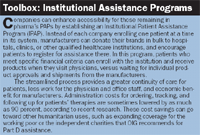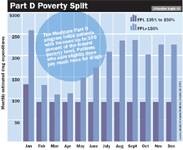Patient Assistant Programs and Medicare Part D
Pharmaceutical Executive
Patient-Program Interface Nearly one-third (2.5 million) of the estimated eight million Americans currently enrolled in PAPs are over age 65 and will be eligible to participate in the government's Part D program.
With the medicare part d prescription drug benefit program in effect, pharmaceutical companies have to decide how to handle the estimated 2.5 million low-income seniors who have been part of their patient assistance programs (PAPs). In many cases, it no longer makes sense for drug companies to continue to allow Medicare-eligible patients into their PAPs when more comprehensive assistance through Part D is available and the government is absorbing the cost.

Make the Switch
At the same time, the transition of Medicare-eligible seniors from PAPs to Part D coverage will be far from seamless. The new drug benefit doesn't align perfectly with existing PAPs, so many seniors on PAPs who had benefited from free or sharply reduced prices for their medicines are worse off on Part D plans.
Pharmaceutical companies must carefully decide what support they will offer to PAP members. Those decisions include whether Medicare enrollees should continue to be eligible for company-sponsored PAPS, how best to encourage them to sign up for Medicare, and how to ensure that patients who do switch coverage continue to receive the medicines they require.
However, the industry will take its next steps toward redefining PAPs in the Part D environment under strict government guidance and scrutiny. Already, the Office of Inspector General (OIG) has placed severe limitations on companies willing to offer Part D-enrolled patients additional assistance in affording their prescription drugs.

Toolbox: Institutional Assistance Programs
The Rub
Nearly one-third (2.5 million) of the estimated eight million Americans currently enrolled in PAPs are over age 65 and are eligible to participate in the government's drug benefit program, available to all seniors and disabled individuals who qualify for Medicare, regardless of financial status. Historically, Medicare has covered hospital stays and in-patient medications; patients had to pay for medications out of pocket or enroll in a prescription drug plan to obtain their routine medications. To help those patients who could not afford their drugs, companies created PAPs, which offered free or reduced-priced therapies to qualified low-income patients, as determined by the manufacturer providing the program. The first PAPs were established more than 25 years ago, by such companies as Astra and Hoechst-Roussell. Today, PAPs are an industry standard, with companies' programs distributing $4 billion worth of drugs to needy patients in 2004, according to PhRMA.
The new Medicare Part D program, implemented through private health insurance companies, adds outpatient medications to the list of services for which Medicare pays. Although it's up to the insurance companies exactly what premiums are required and which drugs their programs will cover, the government has set guidelines for the plans relative to the categories and number of drugs that must be available in each category. Just like payers outside the Medicare realm, it is clear that many plans favor lower-priced generics over more expensive brand-name drugs.

Part D Poverty Split
The Medicare Part D program is truly beneficial for impoverished patients who live at the federal poverty level (FPL)—$9,570 for an individual, $12,830 for a two-member household—or up to 150 percent over the FPL, if they qualify for the low-income subsidy. Those patients will receive their medication with a very modest out-of-pocket cost, a nominal co-pay of $1 to $3, and pay no monthly premium.
The rub between the Medicare Part D program and PAPs affects the group of patients with income over 150 percent FPL. Seniors living above 150 percent FPL—$14,355 for an individual and $19,245 for a two-person household—will likely pay a monthly premium ranging from $20 to $35 plus a $250 deductible. After that first $250, patients will be responsible for 25 percent of the drug cost until out-of-pocket costs reach $2,250. Then comes the "doughnut hole," where patients bear the full burden of cost until they reach a total of $5,100 annual out-of-pocket cost. Patients will then be responsible for five percent of the cost of their prescription medicines. That's a lot of money for these patients, especially if they previously received free medications through pharma PAPs. After all, industry PAPs typically cast a wider net than Part D plans, covering patients with incomes up to 200 percent of FPL, with some, like Novartis' program for Gleevec (imatinib), extending well beyond.
"Part D Poverty Split" illustrates how people earning more than 150 percent of FPL pay substantially more for drugs than people whose incomes lie between 135 percent and 150 percent of FPL. However, the fact that these patients are a little better off, doesn't mean they can cope with drug plan deductibles, co-pays, and premiums. So companies are in a tough position: If all pharmas denied assistance to those eligible for Medicare, up to one million low-income patients could fall between the cracks, left with no option other than enrolling in Medicare, which they know they cannot afford.
The OIG Challenge
OIG allows pharmaceutical manufacturers to continue offering PAPs to patients who qualify for Part D coverage, if they do not enroll in the government's program. However, once a patient enrolls in the Medicare Part D program, there are strict limitations on participation in PAPs.
In particular, OIG has given guidance against direct co-pay assistance by pharma companies. In a November 2005 advisory bulletin, OIG stated, "Pharmaceutical manufacturer PAPs that subsidize Part D cost-sharing amounts present heightened risks under the anti-kickback statute." Instead, long-standing OIG guidance makes clear that pharmaceutical manufacturers should make cash donations to independent, bona fide charitable assistance programs, such as a non-profit co-pay relief program like the Patient Advocate Foundation, a national non-profit 501(C)3 patient-services organization.
The OIG rules aim to prevent any pharmaceutical company from convincing patients in the government program to take particular drugs. The compliance body reckons that pharmaceutical companies offering doughnut-hole or co-pay assistance to afford one of the company's own products potentially provide an incentive for the patient to stay on a more expensive product when less costly options exist.
Instead, companies that donate funds to foundations assist patients "without regard to the pharmaceutical company's interests and without regard to the beneficiary's choice of product, provider, supplier, or Part D drug plan," according to the November advisory. This type of donation offers protection by eliminating even the perception of improper inducements by any donor or co-pay assistance program. However, many drug manufacturers may hesitate to contribute money that might be used to purchase competitive products. If a company decides not to participate in such a foundation, it should seek an OIG advisory opinion for before designing an alternative program.
Across the Spectrum
In 2002, with the industry facing increasingly strong public pressure, several pharma companies joined together to create the TogetherRx discount card program. Abbott Laboratories, AstraZeneca, Aventis, Bristol-Myers Squibb, GlaxoSmithKline, Janssen Pharmaceutica, Novartis, and Ortho-McNeil offered seniors 20 to 40 percent discounts on 155 medicines, and at least a 15 percent savings on the cost of generic drugs. Similar discount programs were implemented by individual companies, such as Lilly, Merck, and Pfizer. However, these efforts were stopgaps, intended only to function until Medicare Part D took effect.
In mid-2005, news came that the TogetherRx program would end on December 31, 2005. Since then, individual companies have made decisions about the future of their PAPs. Company strategies for the PAPs cut across a wide spectrum.
PFIZER AND BMS Pfizer and Bristol-Myers Squibb, which have two of the largest PAPs, will continue to offer their programs to Medicare-eligible patients who do not have prescription drug coverage and decide not to enroll in one of the Part D plans. At the same time, both companies are actively participating in and promoting the Partnership for Prescription Assistance, a single point of access to more than 275 PAPs, including more than 150 offered by pharmaceutical companies.
ELI LILLY The LillyAnswers program allowed seniors and people with disabilities under Medicare to pay a flat $12 fee for a 30-day supply of certain retail-distributed Lilly drugs, such as the osteoporosis drug Evista (raloxifene), Humalog (insulin), and antidepressant Cymbalta (duloxetine), among other medicines. The Indianapolis-based drug maker said it will continue to offer its discount program for Medicare-eligible seniors through the last day of open enrollment, May 15, 2006, to offer seniors a "bridge" to the more comprehensive Part D plan. To help patients make the switch, the company established the Lilly Medicare Education hotline to answer questions for individuals interested in enrolling in the Medicare program.
ASTRAZENECA AstraZeneca also set up a toll-free hotline to help members of the AstraZeneca Foundation Patient Assistance Program understand their Part D plan options and make a trasition to the new program. As of December 31, Medicare-eligible members of the company's PAP no longer qualify for that program. Prior to this decision, uninsured US citizens of all ages with a valid Social Security number, who had an annual income below $18,000 per individual or $24,000 for couples and met the requirements of the program, were eligible to receive AstraZeneca products like Crestor (rosuvastatin) and Nexium (esomeprazole) for free.
Other companies are facing similar dilemmas but many, especially smaller pharmas, have yet to announce decisions about their PAPs. Many patients and healthcare providers are anxiously awaiting word.
PAPs have become the only safety net for many individuals who need but lack the income to pay for drugs or drug coverage plans. That said, the healthcare and governmental communities will closely watch how these humanitarian programs fit into the Part D environment. OIG in particular will scrutinize pharma's response to the plight of its former patients.
However, while drug companies change their philanthropic programs for seniors so that they align with Part D, it's important to remember that companies will still run robust charitable initiatives. Although nearly one-third of patients enrolled in PAPs are over age 65, the great majority are younger and will still need assistance. Thus, an opportunity is emerging to improve care for those who remain eligible for PAPs after Part D implementation. This can be accomplished by using some of the dollars saved when PAP patients shift to Part D coverage to expand access to drugs for those who still qualify for PAPs, such as the working poor.
Bill Shearer is executive vice president and COO of The Franklin Group. He can be reached at bshearer@franklinpharmaservices.com

Navigating Distrust: Pharma in the Age of Social Media
February 18th 2025Ian Baer, Founder and CEO of Sooth, discusses how the growing distrust in social media will impact industry marketing strategies and the relationships between pharmaceutical companies and the patients they aim to serve. He also explains dark social, how to combat misinformation, closing the trust gap, and more.
Pfizer, GSK Gain ACIP Recommendations for RSV and Meningococcal Vaccines
April 18th 2025The Centers for Disease Control and Prevention’s Advisory Committee on Immunization Practices voted to expand access to Pfizer’s respiratory syncytial virus vaccine Abrysvo for high-risk adults in their 50s and voted in favor of GSK’s meningococcal vaccine, Penmenvy, for streamlined adolescent protection.